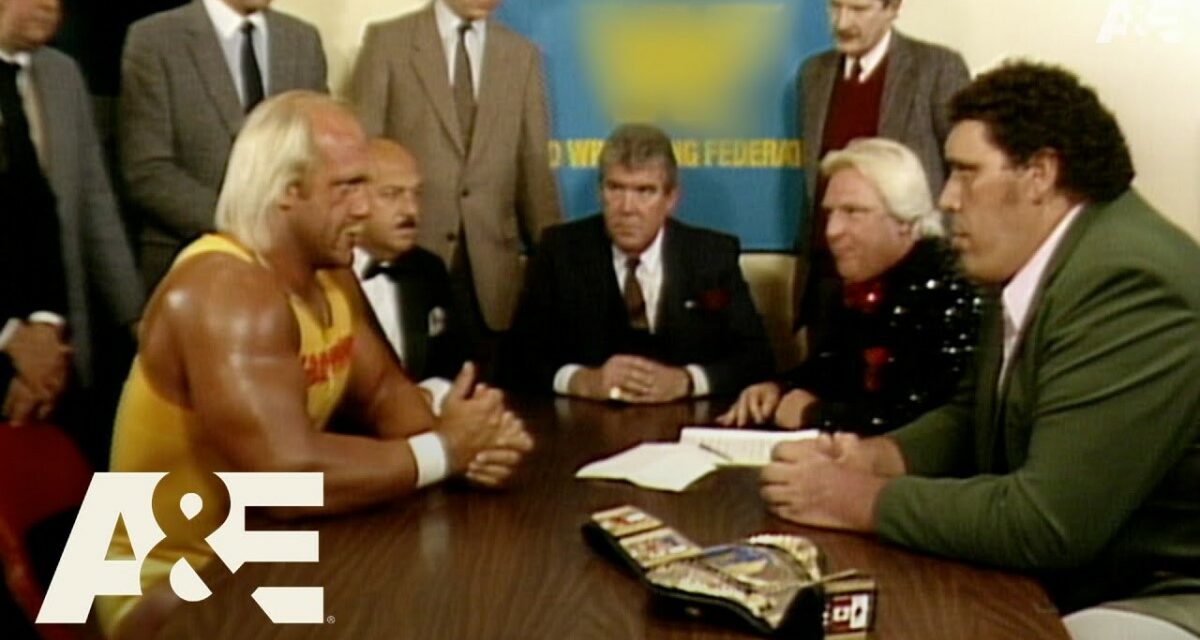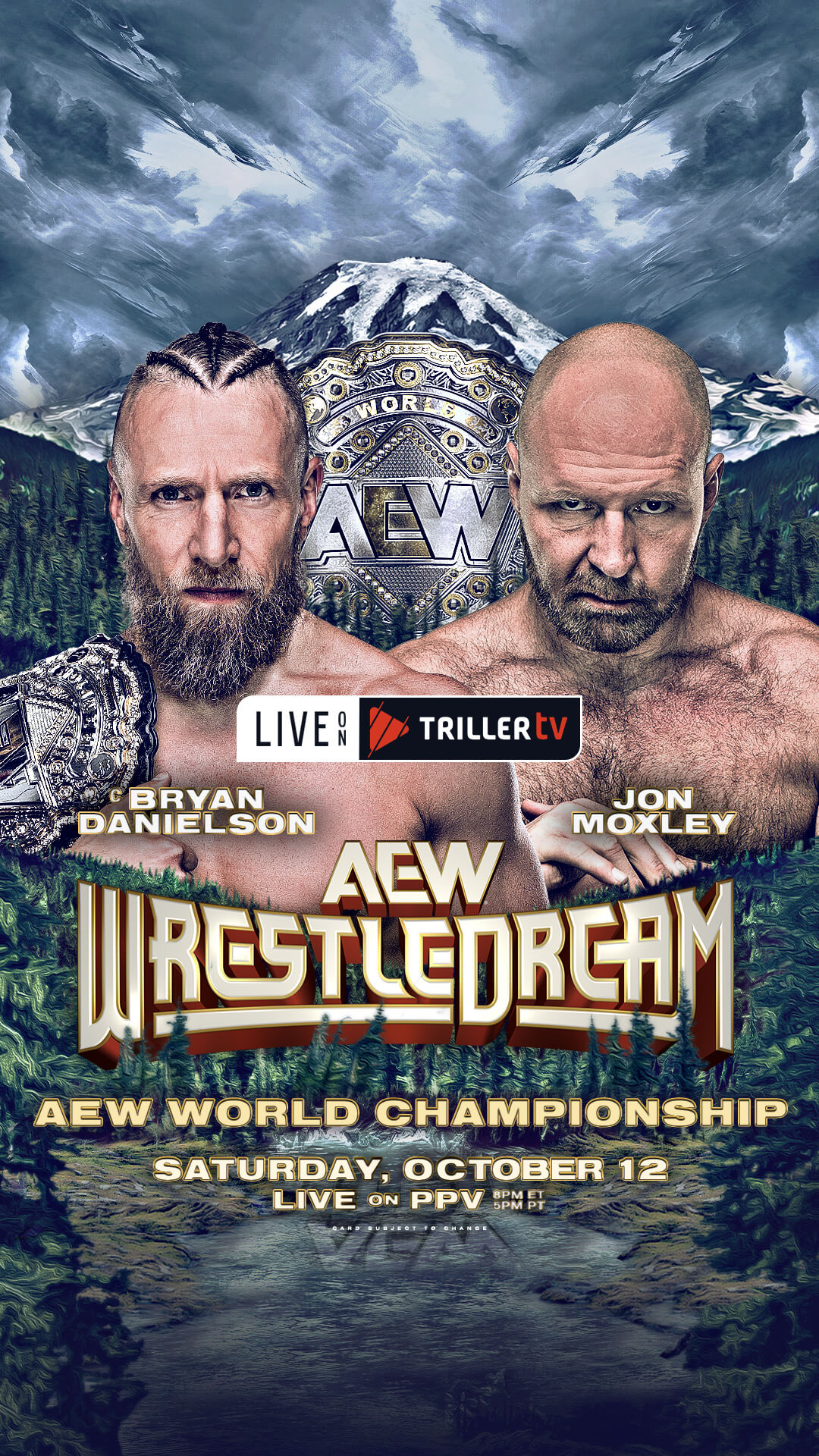The phrase “WWE Universe” is, of course, the current description for the promotion’s fans, but it also aptly describes the self-invented truths that the company presents as its own history. When the WWE production team works alongside A&E on its Biography or Rivals series, though, we as fans get a little moderation on the way WWE tells its own stories — which is to say it’s just a little more real.
In the case of the premiere episode of this season’s Rivals, featuring Hulk Hogan vs. André the Giant, telling more of a compete story and not just a promotional version makes this one of the best recounts of the tale between these two, which more often than not is presented as only the events that took place surrounding WrestleManias III and IV.
The show continues last season’s format of introducing a roundtable of voices to offer memories and insight on the events, and this episode’s crew consists of superfan (and former WWE writer) Freddie Prinze, Jr., Booker T, Natalya, D-Von Dudley, and John Bradshaw Layfield. They begin by calling this the most important rivalry in the history of WWE, and one that “started it all” for the-then WWF. Out of context, that seems like a strange way to describe the main event of the third WrestleMania, and you’d be forgiven for wondering how Roddy Piper, Mr. T, and Hulk Hogan weren’t the ones that started it all.
Even though the episode doesn’t explicitly explain this, you must consider that, again, when WWE has looked back upon Hogan vs, André in the past, they almost always start with the Piper’s Pit that featured the Giant aligning himself with Bobby “The Brain” Heenan to turn heel and challenge Hogan for the title. They traditionally didn’t look back on the times when heel Hulk Hogan, managed by “Classy” Freddie Blassie, was chasing after the babyface André in the very early 80s because it didn’t exactly fit with the narrative for one big reason.
Going into WrestleMania III, André was billed as undefeated for the prior 15 years, along with having never been slammed. Well, the Giant had incurred losses, but not to Hulk Hogan at least, and the idea that André had a fifteen year undefeated streak was certainly believable. The body slamming bit was more problematic, as not only had it happened many times before, but Hogan had even done it more than once as a heel!
So, with all of that in mind, Rivals succeeds by presenting a much broader look at the in-ring history between the two, their contentious early relationship, and how all of that led to an undeniably historic moment at WrestleMania III. Looking through a wider lens, the notion that this rivalry set things in motion for Hulkamania to even exist, long before these two met at WrestleMania III, makes sense.
On top of the commentary from the roundtable, there are interview clips, some new and some archival, with those involved or closest to André and Hulk. To a person, everyone confirms the great, friendly qualities of the Giant that have been told before — Stephanie McMahon remembers how kind he was to her as a kid — but that if he didn’t like you he didn’t have to budge for anything he didn’t want to put up with.
Hogan recalls his own green, somewhat arrogant attitude starting out, after Mike Graham famously helped him break into wrestling by setting up a training session with Hiro Matsuda (who promptly broke Hogan’s leg to introduce him to the weird world of the sport). That experience hardened Hogan’s outlook, and he was determined to prove himself. When he was set up against the babyface André by Vince McMahon, Sr., Hogan realized very quickly that André didn’t much care for his attitude, and the Giant “beat the crap” out of him night after night.
Sean Mooney talks about Hogan and André’s time working with each other for New Japan Pro Wrestling, and how the Giant’s rough treatment of Hogan was partly due to Hulk’s own stiff work. Hogan says he finally understood that André was trying to help him learn how to work properly, and after that they became much friendlier with each other. At this time, as told by Keith Elliot Greenberg, Hogan’s path to babyface was becoming clear, as fans wanted to cheer for him even as he played the bad guy.
While André’s health was deteriorating, Hogan’s turn to American hero (along with the big splash he made appearing in Rocky III), made it clear that it was Hogan’s time to lead the company, and when Hulkamania began at Madison Square Garden with a leg drop on The Iron Sheik, André was right there to celebrate with the champ. Given the provided context of how Hogan says he thinks André saw big potential in him even when they weren’t seeing eye to eye, it’s a nice moment between the two.
And that’s the point where the history between Hogan and André would usually start in promo packages. The rest is well-covered territory: the Giant enlists Bobby Heenan and chases after Hogan’s title (a clip from Roddy Piper in 2014 has Hot Rod acknowledging that a promo couldn’t have gone better than André’s heel turn on Piper’s Pit). There’s a record-setting crowd in Pontiac, Michigan, and a nod to its importance by JBL who explained that WrestleMania II was not much of a success, so the third iteration had to hit it out of the park.
Mooney says that it was “a big ask” for André to get in the ring and work that match with all the pain he was enduring (it was around this time, filming for The Princess Bride, that André famously needed assistance for a scene in which he held up the featherweight Robin Wright in his arms). In the end, of course, the Giant called for Hogan to slam him and they created a moment that will play now, then, and forever for WWE. Hogan, who claims to have been legitimately concerned about what would happen in that match, gets emotional talking about how André didn’t have to do that body slam for him.
The rest of the episode touches on their clash for the championship in February of 1988, the one where plastic surgery shenanigans gave André the title for a few moments before he passed it on to Ted DiBiase (who appears in the episode to, well, laugh), skipping over WrestleMania IV and ending with a July 31, 1988 cage match to cap off Hogan and André’s story.
By this point, André is in constant, terrible pain, and Sean Mooney again says that it was physically amazing for the Giant to perform in a cage match at all. André makes a return to the set of Brutus Beefcake’s barbershop in June of 1991, with Hogan and Mooney commenting that he was miserable without being able to perform in the ring. A couple of years later, André passed away, leaving a legacy that is larger than life yet curiously overlooked in a way, as his prime wrestling days were before the 1980 wrestling boom and most clips of him feature him in his less impressive stages.
This episode puts some of that back in order, expanding on the most-told parts of this rivalry to paint a bigger, more interesting picture. If every episode of Rivals could do this, we’d have a great show on our hands. Stay with SlamWrestling.net for future reviews, and fingers crossed that the season keeps it up!
RELATED LINKS
- André the Giant story archive
- Hulk Hogan story archive
- Slam Wrestling’s A&E/WWE archive


